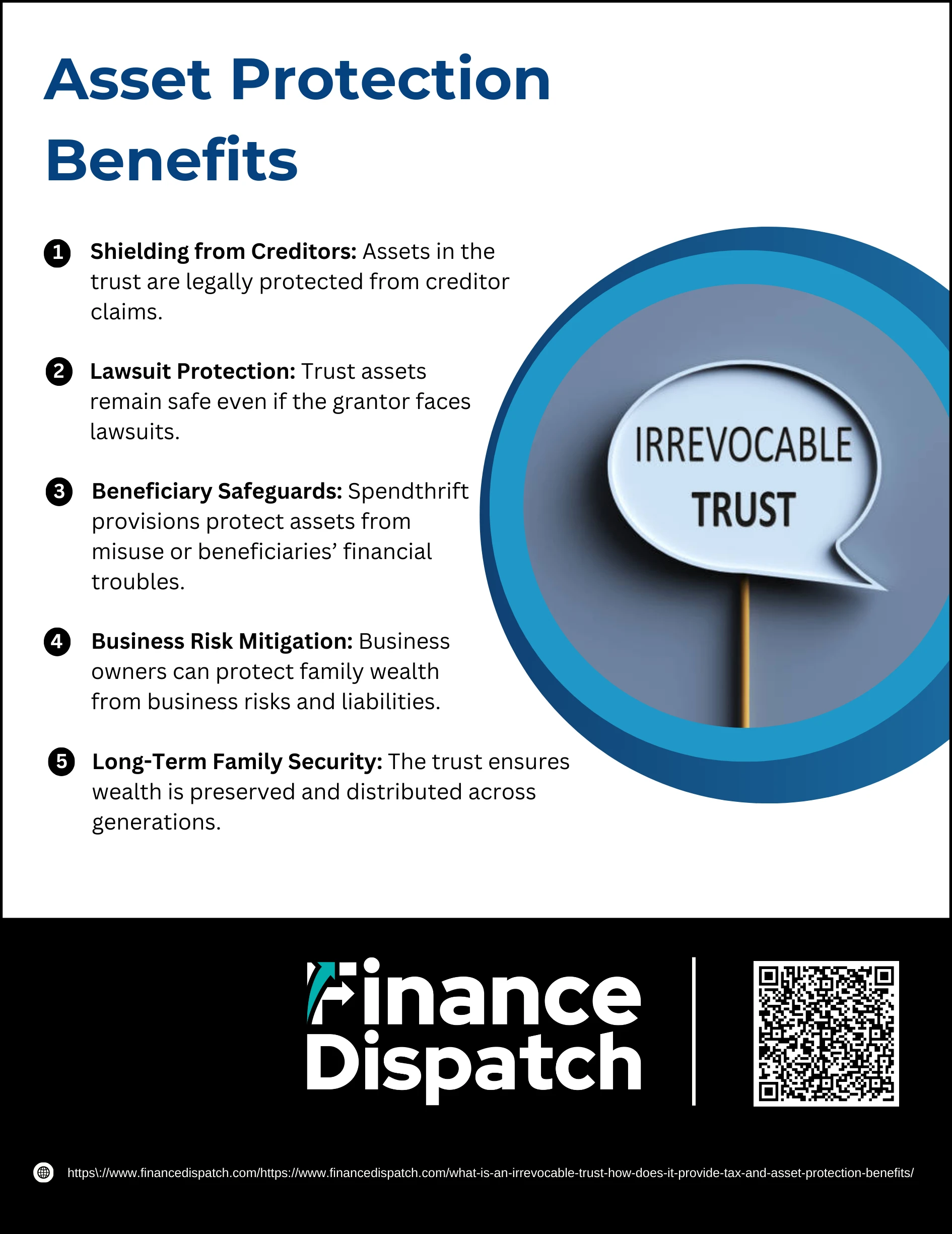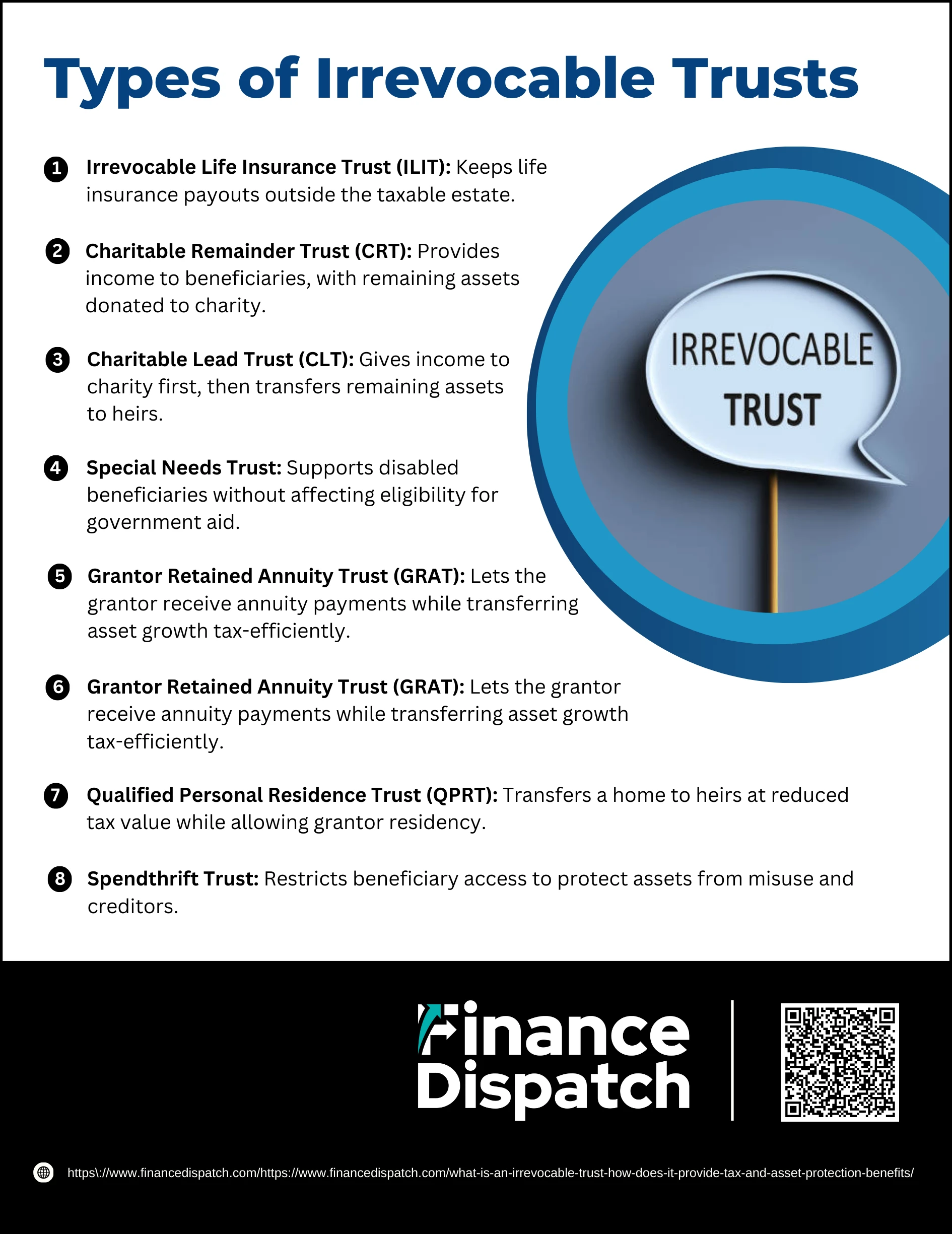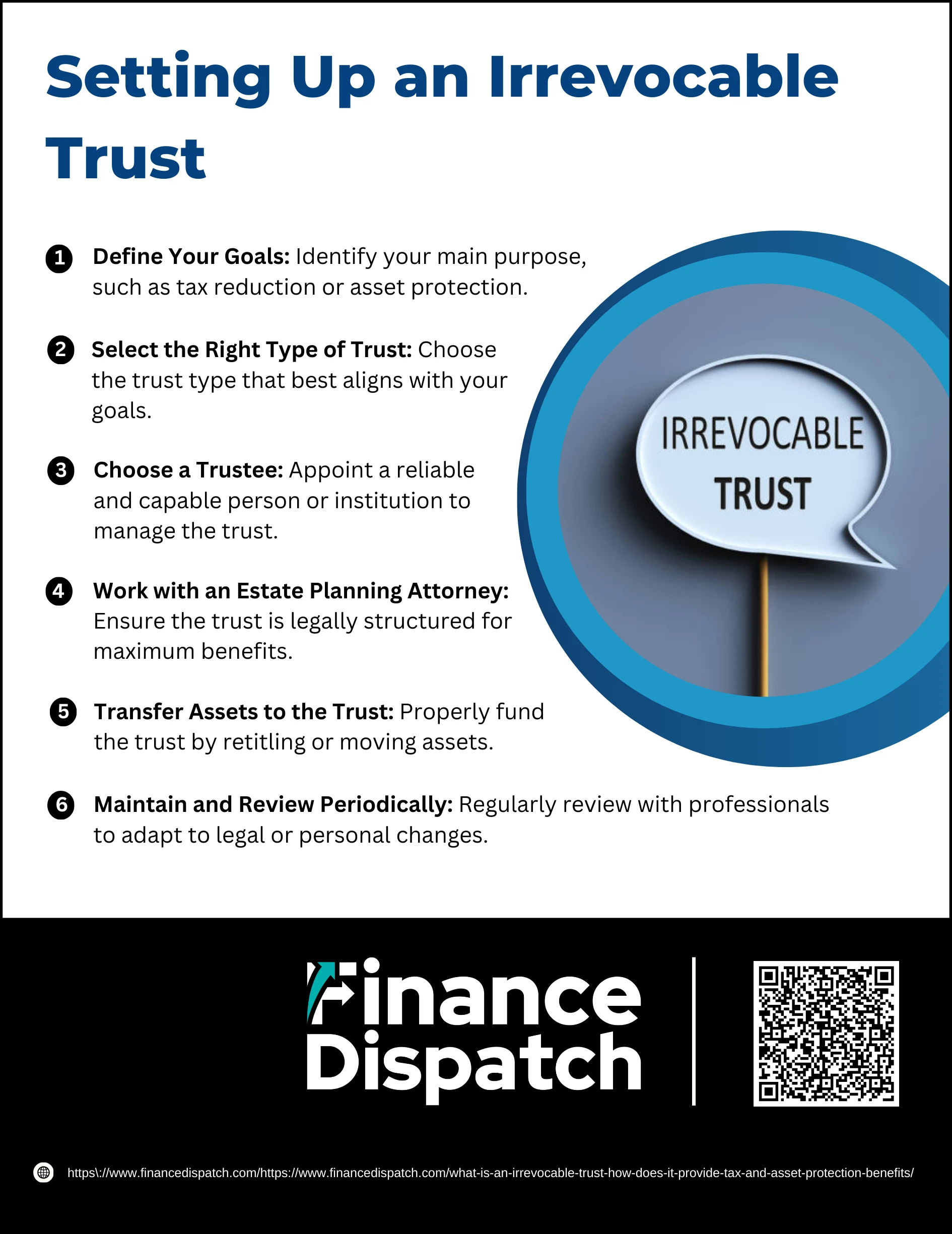Planning for the future often means finding ways to protect your wealth and reduce the burden of taxes on your estate. One of the most effective tools for doing so is an irrevocable trust. Unlike other types of trusts, once assets are placed in an irrevocable trust, they are legally separated from the grantor’s personal estate, making them more secure from creditors, lawsuits, and unnecessary taxation. This unique structure not only preserves wealth for beneficiaries but also offers powerful tax advantages, ensuring that more of what you’ve earned is passed down to your loved ones. In this article, we’ll explore what an irrevocable trust is, how it works, and the ways it can provide both tax efficiency and long-term asset protection.
What is an Irrevocable Trust?
An irrevocable trust is a legal arrangement where you, as the grantor, transfer ownership of your assets to a trustee who manages them for the benefit of your chosen beneficiaries. Once created, the trust cannot be easily changed, amended, or revoked without the consent of the beneficiaries or a court order. This permanence is what sets it apart from a revocable trust. By giving up control, you remove those assets from your personal estate, which can provide significant legal and financial benefits, such as reducing estate taxes and shielding property from creditors. In short, an irrevocable trust is designed to protect wealth and ensure it is managed and distributed according to your long-term goals.
 How Irrevocable Trusts Work
How Irrevocable Trusts Work
An irrevocable trust functions by permanently transferring ownership of assets away from the grantor. Once in place, the assets are managed by a trustee according to the instructions written in the trust document. This structure provides strong legal and financial protection while also creating tax benefits. Here’s a step-by-step look at how it works in practice:
1. Asset Transfer
The first step is for the grantor to move assets—such as real estate, investments, business interests, or life insurance policies—into the trust. Once transferred, these assets legally belong to the trust, not the grantor. This action is key because it removes the property from the grantor’s personal estate, which reduces exposure to taxes and creditors.
2. Role of the Trustee
After assets are placed in the trust, a trustee takes on the responsibility of managing them. The trustee has a fiduciary duty, meaning they must act in the best interests of the beneficiaries. Depending on the trust’s terms, the trustee may oversee investments, handle tax filings, and make distributions when needed. Choosing a reliable and capable trustee is crucial for the success of the trust.
3. Beneficiary Designation
Every irrevocable trust specifies beneficiaries—the individuals or organizations that will eventually benefit from the trust’s assets. The grantor can define exactly how and when beneficiaries receive distributions. For example, the trust may provide regular payments, release funds when a child reaches a certain age, or allocate resources for education or medical needs.
4. Loss of Grantor Control
One of the defining features of an irrevocable trust is that the grantor gives up direct control over the assets once they are transferred. The grantor cannot unilaterally amend or revoke the trust without the beneficiaries’ consent or a court order. While this may seem restrictive, it is what provides the strong legal protections that make irrevocable trusts valuable.
5. Ongoing Management
The trust continues to operate under the trustee’s management for as long as its terms require. The trustee may invest assets, distribute income, or maintain property until the trust ends. This long-term management ensures that assets are preserved, beneficiaries are supported, and the grantor’s wishes are carried out exactly as intended.
 Asset Protection Benefits
Asset Protection Benefits
An irrevocable trust acts like a shield around your assets. Once you place property, investments, or other valuables into the trust, they are no longer part of your personal estate. This separation makes it much harder for creditors, lawsuits, or even irresponsible spending habits to threaten the wealth you want to pass down. Here are the main ways irrevocable trusts provide strong protection:
1. Shielding from Creditor
When assets are moved into an irrevocable trust, they legally stop belonging to you as the grantor. Because of this, creditors cannot target those assets to collect unpaid debts. For example, if someone sues you and wins a judgment, your personal property may be at risk—but the assets inside the trust remain protected since they are no longer in your name.
2. Lawsuit Protection
People in high-liability professions, like doctors, business executives, or lawyers, often face the risk of being sued. By placing assets into an irrevocable trust, they can separate their personal wealth from their professional risks. Even if a lawsuit results in damages, the trust assets remain untouchable, ensuring financial stability for the family.
3. Beneficiary Safeguards
An irrevocable trust can include “spendthrift provisions,” which limit how beneficiaries access the assets. This is useful if beneficiaries are too young, financially inexperienced, or facing issues like divorce or bankruptcy. With these protections, creditors of the beneficiary cannot claim trust assets, and distributions are carefully controlled to prevent misuse.
4. Business Risk Mitigation
For business owners, separating personal and business assets is critical. If the business faces financial troubles or legal claims, the assets placed in an irrevocable trust are insulated. This structure not only protects the business but also secures family wealth from being lost in case of unexpected setbacks.
5. Long-Term Family Security
Beyond immediate protection, irrevocable trusts ensure assets are distributed according to the grantor’s wishes. For instance, you can specify that funds are only used for education, medical needs, or milestone events like buying a home. This long-term structure safeguards wealth across generations, preventing it from being lost due to poor decisions or outside claims.
Tax Benefits of Irrevocable Trusts
In addition to protecting assets, irrevocable trusts are highly valued for the tax advantages they offer. By removing assets from the grantor’s taxable estate, these trusts can significantly reduce estate taxes and help preserve more wealth for beneficiaries. Depending on how the trust is structured, it may also provide gift tax exemptions and strategic income tax planning opportunities.
Table: Key Tax Benefits of Irrevocable Trusts
| Tax Benefit | How It Works | Who Benefits Most |
| Estate Tax Reduction | Assets in the trust are excluded from the grantor’s taxable estate, lowering overall estate tax liability. | High-net-worth families with large estates. |
| Gift Tax Exemptions | Transfers to the trust can qualify for annual or lifetime gift tax exemptions, reducing taxable gifts. | Individuals passing wealth to heirs during their lifetime. |
| Income Tax Planning | Income generated by trust assets may be taxed at the beneficiary’s tax rate, which is often lower than the trust’s rate. | Beneficiaries in lower tax brackets. |
| Capital Gains Strategy | Appreciating assets transferred to the trust may avoid estate tax on growth, reducing double taxation. | Families holding rapidly appreciating investments. |
| Generation-Skipping Tax (GST) Savings | Certain irrevocable trusts can avoid GST taxes when assets are passed to grandchildren or future generations. | Families planning multi-generational wealth transfers. |
 Types of Irrevocable Trusts
Types of Irrevocable Trusts
Irrevocable trusts are not one-size-fits-all. Each type is crafted with a specific goal, whether it’s reducing taxes, protecting assets, or providing long-term financial security for loved ones. Below are the most common types, along with how they work and why someone might choose them.
1. Irrevocable Life Insurance Trust (ILIT)
This trust is designed to hold life insurance policies so that the payout (death benefit) is excluded from the grantor’s taxable estate. By doing this, beneficiaries can receive the insurance proceeds without paying estate taxes. It also ensures that the funds are managed responsibly and can even be used to cover estate expenses without burdening heirs.
2. Dynasty Trust
A dynasty trust is built for long-term wealth preservation. It can last for multiple generations, shielding assets from estate taxes, divorces, or creditor claims over time. Families with significant wealth often use this trust to create a legacy that benefits children, grandchildren, and beyond, while minimizing the impact of future taxes.
3. Charitable Remainder Trust (CRT)
With a CRT, the grantor or other beneficiaries receive income from the trust for a set period. Once that term ends, whatever remains is donated to a chosen charity. This setup allows you to enjoy income during your lifetime, secure a charitable deduction, and still make a meaningful philanthropic gift.
4. Charitable Lead Trust (CLT)
A CLT works in the opposite way of a CRT. Here, the charity receives income for a designated number of years, and once that period is over, the remaining assets go to heirs. This trust is useful for families who want to support charitable causes while still ensuring that loved ones ultimately inherit assets at a reduced tax cost.
5. Special Needs Trust
This trust provides financial support to a beneficiary with disabilities without disqualifying them from vital government benefits such as Medicaid or Supplemental Security Income (SSI). It ensures that funds are available for extra care, education, or quality-of-life expenses while maintaining eligibility for public assistance programs.
6. Grantor Retained Annuity Trust (GRAT)
A GRAT allows the grantor to transfer appreciating assets—like stocks or business interests—into the trust while still receiving fixed annuity payments for a set term. At the end of the trust period, the remaining assets pass to beneficiaries with little or no gift tax. It’s a common tool for wealthy families looking to transfer growth assets efficiently.
7. Qualified Personal Residence Trust (QPRT)
This trust is specifically designed for transferring a home to beneficiaries at a lower tax value. The grantor retains the right to live in the home for a set number of years without paying rent. After that period ends, the property is officially owned by the beneficiaries, often with significant tax savings.
8. Spendthrift Trust
A spendthrift trust places strict limits on how beneficiaries can access and use the assets. It is often used when beneficiaries are young, financially inexperienced, or at risk of poor money management. By controlling distributions and protecting the assets from creditors, this trust ensures wealth is preserved for its intended purpose.
Pros and Cons of Irrevocable Trusts
While irrevocable trusts offer powerful benefits, they also come with trade-offs. For many people, the protection and tax advantages outweigh the drawbacks, but it’s important to understand both sides before making a decision. Below are the key pros and cons to consider.
Pros
1. Protects assets from creditors, lawsuits, and other financial claims.
2. Removes assets from the taxable estate, reducing estate tax liability.
3. Provides structured wealth distribution, preventing misuse by beneficiaries.
4. Helps qualify for government benefits like Medicaid without losing assets.
5. Avoids the time, cost, and publicity of probate.
Cons
1. Grantor gives up control over the assets once transferred.
2. Difficult or impossible to amend without court or beneficiary approval.
3. Legal and administrative setup can be complex and costly.
4. Trust income may be subject to higher tax rates than individual income.
5. Poor trustee selection can lead to mismanagement of assets.
 Setting Up an Irrevocable Trust
Setting Up an Irrevocable Trust
An irrevocable trust can be one of the most effective estate planning tools, but creating one requires careful preparation. Since assets cannot easily be taken back once transferred, every step must be handled thoughtfully. Below is a more detailed breakdown of how the process typically works:
1. Define Your Goals
Before setting up a trust, you need to identify your purpose. Are you trying to reduce estate taxes, protect assets from creditors, support a child with special needs, or leave a charitable legacy? Having a clear goal will shape the type of trust and provisions included.
2. Select the Right Type of Trust
Irrevocable trusts come in different forms, each serving a specific function. For example, an Irrevocable Life Insurance Trust (ILIT) keeps insurance proceeds out of your taxable estate, while a Charitable Remainder Trust allows you to support a cause and still provide income for yourself or your heirs. Picking the right trust ensures you achieve your intended outcome.
3. Choose a Trustee
The trustee will have complete control over managing and distributing trust assets. Because of this responsibility, you must select someone trustworthy, financially skilled, and impartial. Some people choose family members, while others rely on professional trustees like attorneys or trust companies to avoid conflicts of interest.
4. Work with an Estate Planning Attorney
An irrevocable trust involves legal language, tax rules, and state-specific regulations that can be overwhelming. An experienced estate planning attorney ensures the document is drafted correctly, avoids loopholes, and maximizes tax and protection benefits. They will also advise on how the trust interacts with other parts of your estate plan.
5. Transfer Assets to the Trust
After the trust agreement is created, the assets must be formally transferred into it. This may include changing property titles, retitling bank or investment accounts, or assigning ownership of insurance policies. Without properly funding the trust, it won’t serve its intended purpose.
6. Maintain and Review Periodically
Even though an irrevocable trust cannot be easily altered, periodic reviews are important. Laws change, and so do personal circumstances. For example, tax law reforms or changes in family dynamics may affect how well the trust still meets its goals. Working with professionals to review the trust regularly ensures it continues to provide maximum benefits.
Conclusion
An irrevocable trust is more than just a legal tool—it’s a powerful strategy for protecting wealth, reducing taxes, and securing your family’s financial future. By permanently transferring assets into a trust, you gain safeguards against creditors, lawsuits, and unnecessary estate taxes while ensuring your legacy is preserved exactly as you intend. Although setting one up requires careful planning and professional guidance, the long-term benefits often far outweigh the loss of control. For individuals seeking both asset protection and tax efficiency, an irrevocable trust can be a cornerstone of a well-structured estate plan.



